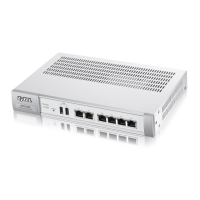Appendix E IPv6
NXC Series User’s Guide
506
ICMPv6
Internet Control Message Protocol for IPv6 (ICMPv6 or ICMP for IPv6) is defined in RFC 4443. ICMPv6 has
a preceding Next Header value of 58, which is different from the value used to identify ICMP for IPv4.
ICMPv6 is an integral part of IPv6. IPv6 nodes use ICMPv6 to report errors encountered in packet
processing and perform other diagnostic functions, such as "ping".
Neighbor Discovery Protocol (NDP)
The Neighbor Discovery Protocol (NDP) is a protocol used to discover other IPv6 devices and track
neighbor’s reachability in a network. An IPv6 device uses the following ICMPv6 messages types:
• Neighbor solicitation: A request from a host to determine a neighbor’s link-layer address (MAC
address) and detect if the neighbor is still reachable. A neighbor being “reachable” means it
responds to a neighbor solicitation message (from the host) with a neighbor advertisement message.
• Neighbor advertisement: A response from a node to announce its link-layer address.
• Router solicitation: A request from a host to locate a router that can act as the default router and
forward packets.
• Router advertisement: A response to a router solicitation or a periodical multicast advertisement from
a router to advertise its presence and other parameters.
IPv6 Cache
An IPv6 host is required to have a neighbor cache, destination cache, prefix list and default router list.
The NXC maintains and updates its IPv6 caches constantly using the information from response
messages. In IPv6, the NXC configures a link-local address automatically, and then sends a neighbor
solicitation message to check if the address is unique. If there is an address to be resolved or verified, the
NXC also sends out a neighbor solicitation message. When the NXC receives a neighbor advertisement
in response, it stores the neighbor’s link-layer address in the neighbor cache. When the NXC uses a
router solicitation message to query for a router and receives a router advertisement message, it adds
the router’s information to the neighbor cache, prefix list and destination cache. The NXC creates an
entry in the default router list cache if the router can be used as a default router.
When the NXC needs to send a packet, it first consults the destination cache to determine the next hop.
If there is no matching entry in the destination cache, the NXC uses the prefix list to determine whether
the destination address is on-link and can be reached directly without passing through a router. If the
address is onlink, the address is considered as the next hop. Otherwise, the NXC determines the next-hop
from the default router list or routing table. Once the next hop IP address is known, the NXC looks into the
neighbor cache to get the link-layer address and sends the packet when the neighbor is reachable. If
the NXC cannot find an entry in the neighbor cache or the state for the neighbor is not reachable, it
starts the address resolution process. This helps reduce the number of IPv6 solicitation and advertisement
messages.
Multicast Listener Discovery
The Multicast Listener Discovery (MLD) protocol (defined in RFC 2710) is derived from IPv4's Internet
Group Management Protocol version 2 (IGMPv2). MLD uses ICMPv6 message types, rather than IGMP
message types. MLDv1 is equivalent to IGMPv2 and MLDv2 is equivalent to IGMPv3.
MLD allows an IPv6 switch or router to discover the presence of MLD listeners who wish to receive
multicast packets and the IP addresses of multicast groups the hosts want to join on its network.

